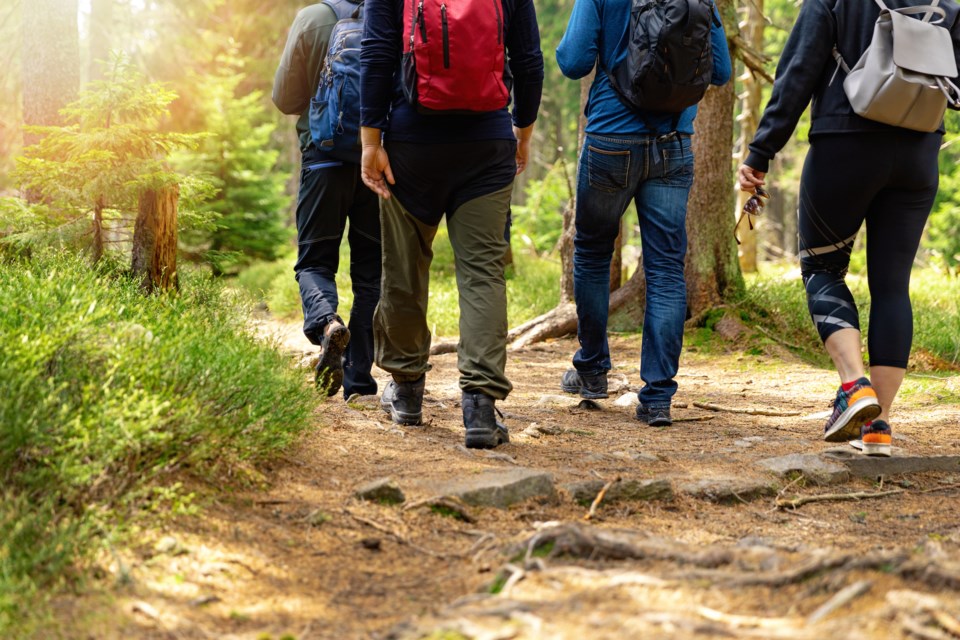GuelphToday received the following letter to the editor from John Fisher, president of the Guelph Hiking Trail Club:
For over 20 years citizens of Guelph have been waiting for an intuitive pedestrian and cycling trail connection between the Guelph to Goderich (G2G) trailhead at Silvercreek Parkway North and downtown Guelph. Community organizations have been disappointed by the lack of municipal progress to address the supposed difficulties to bridge the gap and create a Guelph Trailway.
So, why should we be optimistic that this could happen by 2027?
Well, despite the roadblocks there are many staff generated, council approved plans, regional and national pressures, community organizations and citizens, which support Bridging the Gap and make the status quo untenable.
To begin with, bridging the gap between Woodlawn and Silvercreek is the number one priority in the Trails Master Plan approved by council in 2021. The Guelph Junction Railway (GJR) Ltd 2022 annual report approved by shareholders (council) stated that “grading was continuing, to realign tracks to take into consideration the potential for the Trans Canada Trail system.” GJR have already delivered on the first part of that commitment with grading and rail move over, south of the junction complete. It needs parks to work with GJR to finish the job.
Work on the fourth Trails Master Plan priority, Woodlawn to Speedvale, “a priority project for connection to the Trans Canada Trail,” is underway. The 2025 completion of this “optimum route” will greatly simplify the trailway to downtown.
Council approved the Transport Master Plan (TMP) in 2022. It says the city will support the ongoing enhancement of a bicycle network which includes providing bicycle paths along rail lines and connections to and from provincial and regional cycling routes that facilitate opportunities for tourism and travel to, from and through Guelph.
One recommendation of the TMP which the city has adopted is a Vision Zero approach to eliminate traffic injuries and fatalities. Cyclists and pedestrians must now use Silvercreek because the informal off-road trail is closed. Silvercreek is not designed for this mode of transport. Bridging the gap supports the city’s Vision Zero approach to traffic safety.
The Economic Development and Tourism Department includes the Guelph Junction Railway Ltd. These three divisions are set up to support each other’s mutual economic objectives. The 2022-2026 Economic Development and Tourism Strategy, approved by council identified tourism as a priority sector for economic development. It encourages bike tourism expansion, Ontario by Bike, Bike Friendly Guelph which would all be supported by a safe, intuitive G2G to downtown connection.
The Municipal Accommodation Tax (MAT) was approved by council in 2022. Funds from the tax support marketing Guelph tourism and provide opportunities for local and regional outdoor recreation which supports bridging the gap.
And as recently as July 2023 council approved the Future Guelph Strategic Plan 2024-2027.
The city building theme includes making it easier to get around as an objective. And the people and economy theme includes the objective, grow the local economy through support of businesses, tourism and investment attraction. Both themes and objectives would benefit from bridging the gap. The strengths, weaknesses, opportunities and threats analysis specifically named the Guelph to Goderich Trailway as an opportunity to improve connections to other communities.
The city has just installed a new G2G trailhead kiosk at the covered bridge. It was a 100 Women Who Care Guelph donation to the G2G and the vision of the chair of the G2G Guelph Trailway, Lorenz Calcagno that made this a reality. How nice it would be to show a connected trailway, instead of issuing safety cautions concerning riding up Silvercreek Parkway.
Bridging the gap is a priority for the Trans Canada Trail Association. When they created the spurline to Guelph off the main trail they did not intend it to be discontinuous. They would support Guelph’s efforts to bridge the gap through funding and marketing of a continuous National Trailway into Guelph.
Pressures to bridge the gap are also growing outside of the city. G2G Trailway Management, stewards, townships and organizations report economic benefits accruing to businesses because of the trailway. They are looking to Guelph to participate in their increased economic vibrancy by bridging the gap and turning on the economic faucet to and from downtown Guelph which they would all benefit from.
And lastly, a new Federal Tourism Growth Strategy was announced in July 2023. The Trails Tourism Strategy identifies trails as an important economic contributor to the tourism and local economies and provides and positions trails as important assets among Canada’s suite of outdoor experiences. Bridging the Trans Canada trail gap should be part of that strategy.
You have to be optimistic about all this positive momentum.
However, the mayor and council face difficult fiscal decisions at this multi-year budget cycle which make this project hard for them to get behind despite the benefits. Outdoor organizations and many citizens are still desperate to see this trail completed. There is a provision in the Trails Masters Plan which allows for "community-led, city-supported” trail building.
In 2022 council agreed with parks to move the Speed River Trails West from a city project to a community-led project and asked the Guelph Hiking Trail Club to lead the project. There are now improved recreational trails under the Hanlon with side trails to Imperial Road and Fife Road at no cost to taxpayers. We propose that the Trails Canada North project be reclassified as a “community-led, city-supported” trail. Right now the city plan is to not bridge this gap. So there is no downside and no tax payer implications for a proven trail building community organization to take the lead on this project and bring it to completion by 2027.
We urge you to give staff this direction.
The safety, health and economic vibrancy of citizens and businesses of the City of Guelph will all benefit if council supports actions to make “Bridge the Gap by 2027” a trail building priority.
John Fisher
President, Guelph Hiking Trail Club



